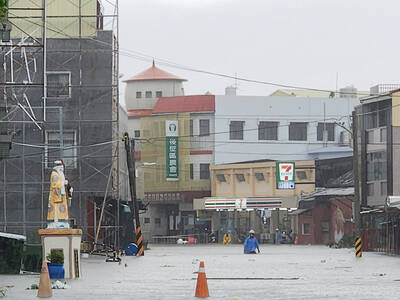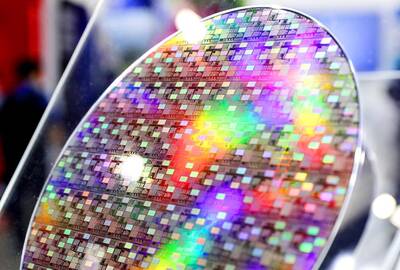Google will make its long-awaited debut in the mobile phone handset market tomorrow when it launches in New York, with its first network partner T-Mobile, the first device that runs its Android operating system.
Called the G1, the new phone is made by Taiwan’s HTC (宏達電) and presents a direct challenge to Apple’s iPhone and the dominance of the world’s largest mobile phone maker, Nokia.
The new handset — which is likely to be characterized as the first G-phone — has a touchscreen like the iPhone but includes a slide-out Qwerty keypad. The phone has previously been referred to as the HTC Dream and the “Kila,” the project name given by T-Mobile and a reference to the network’s hope that it will prove an effective weapon against the iPhone.
The phone is expected to go on sale in the US next month with hopes that it will be available in the UK by Christmas — depending on demand in the North American market. It is expected to cost about US$199, which would put it on a par with the basic 8GB version of the iPhone sold by AT&T.
The arrival of the G1 is the latest salvo in a fight to control the software that will power the next generation of mobile phones, which can access the internet. More devices from other manufacturers will follow next year.
When Google announced its plans for Android last year they came alongside the unveiling of the Open Handset Alliance, a consortium of mobile phone makers and networks whose stated purpose is to “accelerate innovation in mobile and offer consumers a richer, less expensive, and better mobile experience.”
As part of this plan, they made Android a so-called “open platform,” which means no one is charged to use it either in a device or as a basis for writing applications. As a result, anyone can write software that will run on an Android phone — from maps and calendars to word-processing software and games.
A similar developer community has already sprung up around the iPhone, whose software is controlled by Apple although anyone can write applications that will run on it. Users of the phone and the iPod Touch have downloaded the 3,000 applications available from the iTunes store more than 100m times since it opened on July 8.
But iPhone applications are only available through the iTunes store, meaning that Apple controls what is available to users. Applications for the G1 can be downloaded from anywhere, although there is talk that Google, HTC and T-Mobile will set up some sort of applications repository.
Nokia hit back at both Android and the iPhone in June by buying out the British mobile phone software company Symbian and announcing it would make its operating system — which powers about 60 percent of the global “smartphone” market — free.
The hope for Google is that ultimately Android will help more mobile customers get online through their mobile phone.
For many people in the developing world, the only way they are likely to get on the Web, for the foreseeable future, is through a mobile device.
A quarter of a century on from the arrival of the personal computer there are roughly 1 billion in use worldwide but that many mobile phones are sold every year. And growth in mobile usage is increasingly in the developing world, where fixed-line infrastructure is often patchy at best.
Being the first to market will be a source of pride for HTC, which is known mainly as a maker of handsets that run on Microsoft’s Windows Mobile operating system.
LG and Samsung will unveil their first Google-powered mobile phones next year.

Rainfall is expected to become more widespread and persistent across central and southern Taiwan over the next few days, with the effects of the weather patterns becoming most prominent between last night and tomorrow, the Central Weather Administration (CWA) said yesterday. Independent meteorologist Daniel Wu (吳德榮) said that based on the latest forecast models of the combination of a low-pressure system and southwesterly winds, rainfall and flooding are expected to continue in central and southern Taiwan from today to Sunday. The CWA also warned of flash floods, thunder and lightning, and strong gusts in these areas, as well as landslides and fallen

WAITING GAME: The US has so far only offered a ‘best rate tariff,’ which officials assume is about 15 percent, the same as Japan, a person familiar with the matter said Taiwan and the US have completed “technical consultations” regarding tariffs and a finalized rate is expected to be released soon, Executive Yuan spokeswoman Michelle Lee (李慧芝) told a news conference yesterday, as a 90-day pause on US President Donald Trump’s “reciprocal” tariffs is set to expire today. The two countries have reached a “certain degree of consensus” on issues such as tariffs, nontariff trade barriers, trade facilitation, supply chain resilience and economic security, Lee said. They also discussed opportunities for cooperation, investment and procurement, she said. A joint statement is still being negotiated and would be released once the US government has made

SOUTH CHINA SEA? The Philippine president spoke of adding more classrooms and power plants, while skipping tensions with China over disputed areas Philippine President Ferdinand Marcos Jr yesterday blasted “useless and crumbling” flood control projects in a state of the nation address that focused on domestic issues after a months-long feud with his vice president. Addressing a joint session of congress after days of rain that left at least 31 dead, Marcos repeated his recent warning that the nation faced a climate change-driven “new normal,” while pledging to investigate publicly funded projects that had failed. “Let’s not pretend, the people know that these projects can breed corruption. Kickbacks ... for the boys,” he said, citing houses that were “swept away” by the floods. “Someone has

‘CRUDE’: The potential countermeasure is in response to South Africa renaming Taiwan’s representative offices and the insistence that it move out of Pretoria Taiwan is considering banning exports of semiconductors to South Africa after the latter unilaterally downgraded and changed the names of Taiwan’s two representative offices, the Ministry of Foreign Affairs (MOFA) said yesterday. On Monday last week, the South African Department of International Relations and Cooperation unilaterally released a statement saying that, as of April 1, the Taipei Liaison Offices in Pretoria and Cape Town had been renamed the “Taipei Commercial Office in Johannesburg” and the “Taipei Commercial Office in Cape Town.” Citing UN General Assembly Resolution 2758, it said that South Africa “recognizes the People’s Republic of China (PRC) as the sole